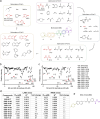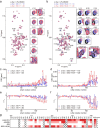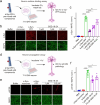Inhibitor Development for α-Synuclein Fibril's Disordered Region to Alleviate Parkinson's Disease Pathology
- PMID: 39327912
- PMCID: PMC11669093
- DOI: 10.1021/jacs.4c08869
Inhibitor Development for α-Synuclein Fibril's Disordered Region to Alleviate Parkinson's Disease Pathology
Abstract
The amyloid fibrils of α-synuclein (α-syn) are crucial in the pathology of Parkinson's disease (PD), with the intrinsically disordered region (IDR) of its C-terminal playing a key role in interacting with receptors like LAG3 and RAGE, facilitating pathological neuronal spread and inflammation. In this study, we identified Givinostat (GS) as an effective inhibitor that disrupts the interaction of α-syn fibrils with receptors such as LAG3 and RAGE through high-throughput screening. By exploring the structure-activity relationship and optimizing GS, we developed several lead compounds, including GSD-16-24. Utilizing solution-state and solid-state NMR, along with cryo-EM techniques, we demonstrated that GSD-16-24 binds directly to the C-terminal IDR of α-syn monomer and fibril, preventing the fibril from binding to the receptors. Furthermore, GSD-16-24 significantly inhibits the association of α-syn fibrils with membrane receptors, thereby reducing neuronal propagation and pro-inflammatory effects of α-syn fibrils. Our findings introduce a novel approach to mitigate the pathological effects of α-syn fibrils by targeting their IDR with small molecules, offering potential leads for the development of clinical drugs to treat PD.
Conflict of interest statement
The authors declare no competing financial interest.
Figures






References
MeSH terms
Substances
LinkOut - more resources
Full Text Sources
Medical
Miscellaneous

